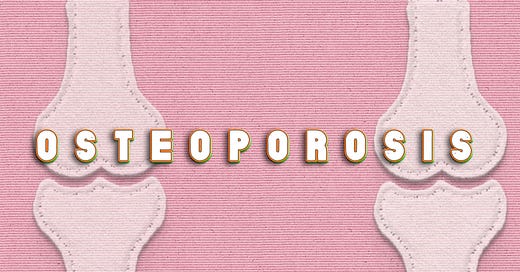Menopausal Hormone Therapy and Osteoporosis Prevention
Reviewing the nuances
Our guide to the hormone menoverse started with the main reasons to take menopausal hormone therapy or MHT. I consider these the “green light” indications because basically every menopause society, the Endocrine Society, and OB/GYN society is in agreement, and it’s not an easy feat to get so many experts to agree! We addressed the first two (hot flashes and night sweats) previously in this post, and as far as vaginal symptoms go, the preferred therapy is vaginal (which we will also address later in this series). This post will focus on the fourth “green light” indication for hormone therapy on the list, the prevention of bone loss.
As you will soon see, nothing is cut and dried because there isn’t really a test result or a family history where the guidelines say, “Start estrogen” for bone health. This is one of those situations that requires individualization, which also means this subject is a little more complicated; hence it gets its own post. With hot flashes, the discussion is basically, “Are these bothering you enough that you want treatment?” and “Is estrogen safe for you?” but when it comes to bone health, it’s not that simple. This complexity also means fears about bone health are ripe for abuse by meno-scammers, who often issue dire proclamations that every woman is doomed without estrogen.
This individualization is an area that I know well because of my own situation. At the end of the post, we’ll use me as a case study, so we can walk through how to apply it to a real-world situation.
Bone Health and Menopause: The Basics
Osteoporosis is a disease of altered bone architecture that decreases bone strength and increases the risk of fractures. The fractures of greatest concern here are the vertebral (spine) and hip, but all fractures can obviously be problematic. Osteoporosis-related fractures are a significant cause of pain, suffering, loss of independence, and even death. My mother died in her eighties of complications related to osteoporosis, and it would be fair to say it ruined the last 15 years of her life.
Bone is constantly being remodeled; old bone is removed by cells called osteoclasts and replaced by bone made by osteoblasts. The balance is tipped towards building bone until our late twenties when we reach peak bone mass (puberty is when the bulk of this bone is built). Achieving the greatest peak bone mass is vital because this is the bone bank you will draw on for the rest of your life. After peak bone mass is achieved, the balance is slightly tipped towards losing bone. With menopause, the rate of bone loss increases because estrogen is an important signaling molecule for building bone.
During the early menopause transition, there is very little additional loss of bone. If you are not regularly skipping periods, you are not losing bone at an accelerated rate. It is in the final 1-3 years of the menopause transition ( 1-3 years before periods stop) when things change. This time, when accelerated bone loss starts, is when there are three or more months between periods, but there was still a period in the past 12 months. At this point, bone density starts to drop about 1-2% a year, and over the next 5-10 years, there can be a 10-12% decrease in bone density.
Look at the graph below, which I have adapted from the National Osteoporosis Foundation’s Position Statement on Osteoporosis. The solid line is typical peak bone mass, and the dashed line depicts the graph for people with factors that affect peak
Keep reading with a 7-day free trial
Subscribe to The Vajenda to keep reading this post and get 7 days of free access to the full post archives.




